Related Research Articles
In music, serialism is a method of composition using series of pitches, rhythms, dynamics, timbres or other musical elements. Serialism began primarily with Arnold Schoenberg's twelve-tone technique, though some of his contemporaries were also working to establish serialism as a form of post-tonal thinking. Twelve-tone technique orders the twelve notes of the chromatic scale, forming a row or series and providing a unifying basis for a composition's melody, harmony, structural progressions, and variations. Other types of serialism also work with sets, collections of objects, but not necessarily with fixed-order series, and extend the technique to other musical dimensions, such as duration, dynamics, and timbre.
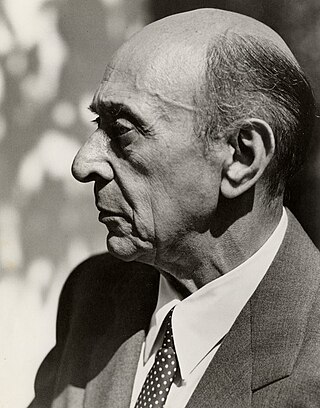
The twelve-tone technique—also known as dodecaphony, twelve-tone serialism, and twelve-note composition—is a method of musical composition first devised by Austrian composer Josef Matthias Hauer, who published his "law of the twelve tones" in 1919. In 1923, Arnold Schoenberg (1874–1951) developed his own, better-known version of 12-tone technique, which became associated with the "Second Viennese School" composers, who were the primary users of the technique in the first decades of its existence. The technique is a means of ensuring that all 12 notes of the chromatic scale are sounded as often as one another in a piece of music while preventing the emphasis of any one note through the use of tone rows, orderings of the 12 pitch classes. All 12 notes are thus given more or less equal importance, and the music avoids being in a key. Over time, the technique increased greatly in popularity and eventually became widely influential on 20th-century composers. Many important composers who had originally not subscribed to or actively opposed the technique, such as Aaron Copland and Igor Stravinsky, eventually adopted it in their music.

Milton Byron Babbitt was an American composer, music theorist, mathematician, and teacher. He was a Pulitzer Prize and MacArthur Fellowship recipient, recognized for his serial and electronic music.
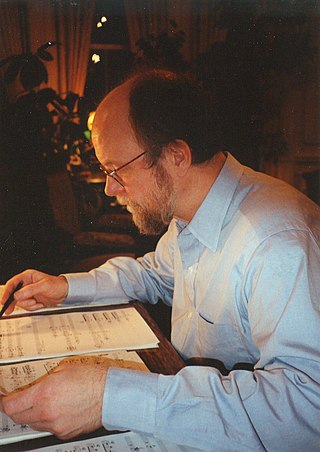
Charles Peter Wuorinen was an American composer of contemporary classical music based in New York City. He also performed as a pianist and conductor. Wuorinen composed more than 270 works: orchestral music, chamber music, solo instrumental and vocal works, and operas, such as Brokeback Mountain. His work was termed serialist but he came to disparage that idea as meaningless. Time's Encomium, his only purely electronic piece, received the Pulitzer Prize. Wuorinen taught at several institutions, including Columbia University and the Manhattan School of Music.
In music theory, a trichord is a group of three different pitch classes found within a larger group. A trichord is a contiguous three-note set from a musical scale or a twelve-tone row.
In music using the twelve-tone technique, derivation is the construction of a row through segments. A derived row is a tone row whose entirety of twelve tones is constructed from a segment or portion of the whole, the generator. Anton Webern often used derived rows in his pieces. A partition is a segment created from a set through partitioning.
In music using the twelve tone technique, combinatoriality is a quality shared by twelve-tone tone rows whereby each section of a row and a proportionate number of its transformations combine to form aggregates. Much as the pitches of an aggregate created by a tone row do not need to occur simultaneously, the pitches of a combinatorially created aggregate need not occur simultaneously. Arnold Schoenberg, creator of the twelve-tone technique, often combined P-0/I-5 to create "two aggregates, between the first hexachords of each, and the second hexachords of each, respectively."
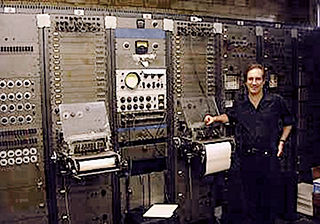
The RCA Mark II Sound Synthesizer was the first programmable electronic synthesizer and the flagship piece of equipment at the Columbia-Princeton Electronic Music Center. Designed by Herbert Belar and Harry Olson at RCA, with contributions by Vladimir Ussachevsky and Peter Mauzey, it was installed at Columbia University in 1957. Consisting of a room-sized array of interconnected sound synthesis components, the Mark II gave the user more flexibility and had twice the number of tone oscillators as its predecessor, the Mark I. The synthesizer was funded by a large grant from the Rockefeller Foundation.
In music a time point or timepoint is "an instant, analogous to a geometrical point in space". Because it has no duration, it literally cannot be heard, but it may be used to represent "the point of initiation of a single pitch, the repetition of a pitch, or a pitch simultaneity", therefore the beginning of a sound, rather than its duration. It may also designate the release of a note or the point within a note at which something changes. Other terms often used in music theory and analysis are attack point and starting point. Milton Babbitt calls the distance from one time point, attack, or starting point to the next a time-point interval, independent of the durations of the sounding notes which may be either shorter than the time-point interval, or longer. Charles Wuorinen shortens this expression to just time interval. Other writers use the terms attack interval, or, interval of entry, interval of entrance, or starting interval.
J. D. Parran is an American multi-woodwind player, educator, and composer specializing in jazz and free improvisation. He plays the soprano, alto, tenor, baritone, and bass saxophone, as well as the E-flat clarinet, alto clarinet, bass clarinet, contra-alto clarinet, piccolo, alto flute, bamboo flute, Native American flute, bamboo saxophone, and nagaswaram.
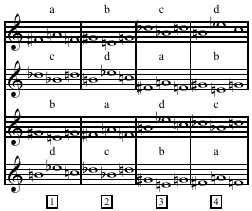
Composition for Four Instruments (1948) is an early serial music composition written by American composer Milton Babbitt. It is Babbitt's first published ensemble work, following shortly after his Three Compositions for Piano (1947). In both these pieces, Babbitt expands upon the methods of twelve-tone composition developed by Arnold Schoenberg. He is notably innovative for his application of serial techniques to rhythm. Composition for Four Instruments is considered one of the early examples of “totally serialized” music. It is remarkable for a strong sense of integration and concentration on its particular premises—qualities that caused Elliott Carter, upon first hearing it in 1951, to persuade New Music Edition to publish it.
The Group for Contemporary Music is an American chamber ensemble dedicated to the performance of contemporary classical music. It was founded in New York City in 1962 by Joel Krosnick, Harvey Sollberger and Charles Wuorinen and gave its first concert on October 22, 1962 in Columbia University's MacMillin Theatre. Krosnik left the ensemble in 1963. It was the first contemporary music ensemble based at a university and run by composers.
Third stream is a music genre that is a fusion of jazz and classical music. The term was coined in 1957 by composer Gunther Schuller in a lecture at Brandeis University. There are many ways to define third-stream music. It could refer to a group of jazz musicians playing solely, or a jazz soloist performing with a symphony orchestra, as long as the musicians are able to interpret and play jazz music. Improvisation is generally seen as a vital component of third stream. In third-stream music, composers incorporated elements of classical music, such as the use of jazz instruments and classical music forms, into their jazz compositions. The fusion of jazz and classical music is also viewed as "born out of a reciprocal interest: the interest of the classical community in the developments in jazz music and the interest of the jazz community in the advances of classical music." The innovative idea of fusing jazz and classical music pushed the boundaries of traditional classical music and introduced a new genre that blends the two styles into a unique hybrid form.
Peter Jarvis is an American percussionist, drummer, conductor, composer, music copyist, print music editor and college professor.
In music, the "Ode-to-Napoleon" hexachord is the hexachord named after its use in the twelve-tone piece Ode to Napoleon Buonaparte Op. 41 (1942) by Arnold Schoenberg. Containing the pitch-classes 014589 it is given Forte number 6–20 in Allen Forte's taxonomic system. The primary form of the tone row used in the Ode allows the triads of G minor, E♭ minor, and B minor to easily appear.
Composition for Twelve Instruments is a serial music composition written by American composer Milton Babbitt for flute, oboe, clarinet, bassoon, horn, trumpet, harp, celesta, violin, viola, cello, and double bass. In it Babbitt for the first time employs a twelve-element duration set to serialize the rhythms as well as the pitches, predating Olivier Messiaen's (non-serial) "Mode de valeurs et d'intensités", but not the Turangalîla-Symphonie (1946–1948), in which Messiaen used a duration series for the first time in the opening episode of the seventh movement, titled "Turangalîla II".
String Quartet No. 2 (1954) is the second of six string quartets by the American composer Milton Babbitt.

The Wind Quintet, Op. 26, is a chamber music composition by Arnold Schoenberg, composed in 1923–24. It is one of the earliest of Schoenberg's compositions to use twelve-tone technique.
Robert Miller was an American pianist and attorney.
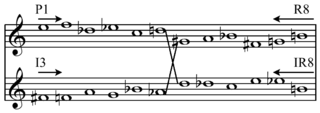
In music theory, the chromatic hexachord is the hexachord consisting of a consecutive six-note segment of the chromatic scale. It is the first hexachord as ordered by Forte number, and its complement is the chromatic hexachord at the tritone. For example, zero through five and six through eleven. On C:
References
- ↑ Wuorinen 1974.
- ↑ Babbitt 1963, p. 3.
- ↑ Barkin 2001.
- ↑ Simms 1986, p. 344.
- ↑ Stuessy 1978, pp. 176–178.
- ↑ Babbitt 1987, pp. 115–117.
- ↑ Stuessy 1978, p. 166.
- ↑ Arnold & Hair 1976, p. 159.
- ↑ Arnold & Hair 1976, p. 160.
- ↑ Babbitt 1955, p. 57.
- ↑ Stuessy 1978, pp. 166–167.
- ↑ Griffiths 2010, p. 155.
- ↑ Stuessy 1978, pp. 179–180.
Sources
- Arnold, Stephen, and Graham Hair. 1976. "An Introduction and a Study: String Quartet No. 3". Perspectives of New Music 14, no. 2/15, no. 1 (Spring-Summer/Fall-Winter): 155–186.
- Babbitt, Milton. 1955. "Some Aspects of Twelve-Tone Composition". The Score and I.M.A. Magazine, no. 12 (June), 53–61.
- Babbitt, Milton. 1963. All Set, for Jazz Ensemble (1957). Study score. AMP-96417-48. New York: Associated Music Publishers.
- Babbitt, Milton. 1987. Words about Music, edited by Stephen Dembski and Joseph N. Straus. The Madison Lectures. Madison: University of Wisconsin Press. ISBN 0299107906 (cloth); ISBN 0299107949.
- Barkin, Elaine. 2001. "Babbitt, Milton (Byron)". The New Grove Dictionary of Music and Musicians , second edition, edited by Stanley Sadie and John Tyrrell. London: Macmillan Publishers.
- Griffiths, Paul. 2010. Modern Music and After, third edition. Oxford and New York: Oxford University Press. ISBN 978-0-19-974050-5.
- Simms, Bryan R. 1986. Music of the Twentieth Century: Style and Structure. New York: Schirmer Books. ISBN 0-02-872580-8.
- Stuessy, Clarence Joseph Jr. 1978. "The Confluence of Jazz and Classical Music from 1950 to 1970". PhD diss. Rochester: The University of Rochester, Eastman School of Music.
- Wuorinen, Charles. 1974. Liner notes for Spectrum: New American Music, volume 5. Nonesuch Records LP H-71303.